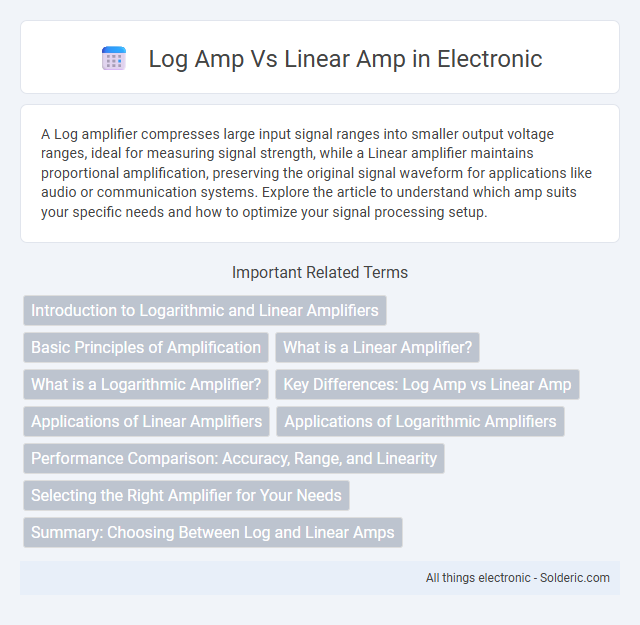A Log amplifier compresses large input signal ranges into smaller output voltage ranges, ideal for measuring signal strength, while a Linear amplifier maintains proportional amplification, preserving the original signal waveform for applications like audio or communication systems. Explore the article to understand which amp suits your specific needs and how to optimize your signal processing setup.
Comparison Table
| Feature | Log Amplifier | Linear Amplifier |
|---|---|---|
| Output Signal | Logarithmic representation of input | Proportional to input amplitude |
| Dynamic Range | Wide dynamic range, compresses large inputs | Narrow dynamic range, linear scaling |
| Application | Signal compression, audio level detection, RF measurements | Audio amplification, RF power amplification |
| Complexity | More complex design, uses nonlinear components | Simple design, linear components |
| Output Sensitivity | Output changes slowly with input | Output changes linearly with input |
| Frequency Response | Typically limited by component nonlinearities | Broad frequency response if designed properly |
Introduction to Logarithmic and Linear Amplifiers
Logarithmic amplifiers convert input signals into a logarithmically proportional output, enabling accurate measurement across a wide dynamic range often used in RF and audio signal processing. Linear amplifiers provide output signals directly proportional to the input, maintaining signal fidelity crucial for amplification without distortion in communication systems. The choice between log amp and linear amp depends on whether dynamic range compression or signal preservation is required for applications like signal detection or transmission.
Basic Principles of Amplification
Logarithmic amplifiers convert input signals into output voltages proportional to the logarithm of the input, enabling accurate measurement of large dynamic ranges in applications like RF signal detection. Linear amplifiers increase the amplitude of the input signal directly without altering its waveform shape, making them ideal for faithful signal reproduction in audio and communication systems. Your choice depends on whether precise signal magnitude measurement (log amp) or signal amplification with minimal distortion (linear amp) is required.
What is a Linear Amplifier?
A linear amplifier is an electronic device that amplifies input signals while preserving their original waveform and frequency characteristics, ensuring minimal distortion and noise. It is widely used in radio frequency (RF) applications, audio systems, and communications to maintain signal integrity and fidelity. Linear amplifiers provide a consistent gain across a wide dynamic range, making them essential for high-precision amplification tasks.
What is a Logarithmic Amplifier?
A logarithmic amplifier (log amp) converts input signals into an output voltage proportional to the logarithm of the input amplitude, enabling a wide dynamic range measurement. Unlike linear amplifiers that provide output directly proportional to input, log amps excel in compressing large input variations for precise signal processing in applications like RF, audio, and instrumentation. Your system can benefit from log amps when accurate detection of signals spanning multiple decades of magnitude is essential.
Key Differences: Log Amp vs Linear Amp
Log amplifiers compress a wide dynamic range of input signals into a manageable output range, making them ideal for applications requiring signal envelope detection or power measurement. Linear amplifiers maintain a proportional output to input voltage, preserving the waveform's shape, which is crucial for high-fidelity audio amplification and RF signal transmission. Your choice between log amp and linear amp depends on whether precise signal amplitude measurement or accurate signal replication is paramount.
Applications of Linear Amplifiers
Linear amplifiers are essential in applications requiring accurate amplification of signals without distortion, such as in audio broadcasting, medical imaging, and RF communication systems. Their ability to maintain signal integrity makes them ideal for high-fidelity sound reproduction and precise instrumentation. Your choice of a linear amplifier ensures optimal performance in environments demanding signal clarity and minimal harmonic interference.
Applications of Logarithmic Amplifiers
Logarithmic amplifiers are widely used in applications requiring precise measurement of input signals with large dynamic ranges, such as RF power detection, audio signal compression, and instrumentation for sensor data processing. Their ability to convert multiplicative signals into additive outputs enables efficient handling of signals varying exponentially, making them ideal for telecommunications, sonar, and medical imaging. These amplifiers excel in scenarios where accurate amplitude scaling and fast signal tracking are crucial, outperforming linear amplifiers in dynamic range and signal compression tasks.
Performance Comparison: Accuracy, Range, and Linearity
Logarithmic amplifiers excel in handling wide dynamic ranges and maintaining consistent accuracy over several decades of input signal variation, making them ideal for signal compression and detection. Linear amplifiers offer superior linearity and amplitude accuracy within a limited dynamic range, which is crucial for applications requiring precise signal amplification without distortion. The choice between log amp and linear amp hinges on the specific needs of accuracy, input range, and linearity in the application, with log amps preferred for broad range and linear amps for exact amplitude fidelity.
Selecting the Right Amplifier for Your Needs
Choosing between a Log amplifier and a Linear amplifier depends on your application requirements and signal characteristics. Log amplifiers excel in measuring a wide dynamic range of signals with high accuracy and are ideal for applications like RF power monitoring and automatic gain control. Linear amplifiers are best suited for situations requiring proportional amplification to maintain signal fidelity, such as audio amplification and precise signal processing, ensuring your system performs optimally.
Summary: Choosing Between Log and Linear Amps
Log amps compress a wide range of input signals into a smaller output range, making them ideal for applications requiring signal strength measurement or dynamic range reduction. Linear amps maintain proportional amplification across their input range, ensuring the output voltage directly corresponds to the input, perfect for audio and communication systems needing faithful signal reproduction. Your choice depends on whether accurate signal amplitude representation (linear amp) or compressed measurement over a vast dynamic range (log amp) is critical for your application.
Log amp vs Linear amp Infographic

 solderic.com
solderic.com